Back to Journals » Journal of Pain Research » Volume 16
Current Status of Research on Tuina for Analgesia: A Bibliometric and Visual Analysis
Authors Wang Z , Xu H, Zhou H, Li W, Yang T, Zhou Y
Received 8 June 2023
Accepted for publication 8 August 2023
Published 29 August 2023 Volume 2023:16 Pages 2955—2970
DOI https://doi.org/10.2147/JPR.S421855
Checked for plagiarism Yes
Review by Single anonymous peer review
Peer reviewer comments 2
Editor who approved publication: Dr Houman Danesh
Zheng Wang,1,* Hui Xu,1,2,* Hang Zhou,1 Wanyu Li,1 Tao Yang,1 Yunfeng Zhou1
1Henan University of Chinese Medicine, Zhengzhou, 450046, People’s Republic of China; 2Tuina Department, the Third Affiliated Hospital of Henan University of Chinese Medicine, Zhengzhou, 450046, People’s Republic of China
*These authors contributed equally to this work
Correspondence: Yunfeng Zhou, College of Acupuncture and Massage, Henan University of Chinese Medicine, No. 156, Jinshui East Road, Zhengzhou, Henan Province, People’s Republic of China, Tel +8615639717497, Fax +86037165962633, Email [email protected]
Purpose: Tuina is a nonpharmacological modality for pain relief that has found applications in the treatment of several pain disorders. Tuina analgesia has been increasingly studied; however, few studies have focused on the previous publication trends, prevalent research areas, collaborations, and other factors. This study aimed to systematically analyze research trends and hot topics in the field of tuina analgesia over the past 30 years, using bibliometric analysis, to inform future research.
Methods: The web of science database was searched for literature on tuina analgesia from 1992– 2023. VOSviewer and CiteSpace were used to analyze annual publication volumes, countries, institutions, journals and CO-cited journals, authorship, articles, and keywords and their relevance, and to perform co-occurrence and clustering analyses.
Results: A total of 621 literature elements were included in the analysis. The annual volume of publications has increased steadily in recent years. The top three high-yielding countries were the United States, China, and Canada, respectively. The top three institutional outputs were from Shanghai University of Chinese medicine, Beijing University of Chinese medicine, and McMaster University, respectively. Notably, there was an imbalance between national outputs and centrality, with higher centrality in the United States (0.35) and lower in China (0.01). Cochrane Database of Systematic Reviews was the journal with the most publications (22), and PAIN was the most influential co-cited journals (publications=306). Moreover, current research in this field was dominated by studies on Tuina for relieving postoperative pain, the effectiveness of Tuina analgesia, and Tuina treatment for pain accompanied by anxiety.
Conclusion: This study employed bibliometrics to analyze the literature on Tuina for pain treatment over a 30-year period, identifying potential collaborators, institutions, hot topics, and future research trends that will inform potential future directions.
Keywords: analgesia, tuina, bibliometric analysis, VOSviewer, CiteSpace
Introduction
Tuina is a method that uses the hands to act on specific parts of the human body surface to regulate the physiological and pathological conditions of the body and to achieve the purpose of physiotherapy. Tuina plays an important role in traditional Chinese medicine and is a highly-characterized, nontraumatic intervention used as a complementary treatment with safe and easy application.1 Tuina is currently used for the sole or complementary treatment of several diseases, especially those with symptoms of pain.2 The most salient symptom of the pain class of disorders, and one of the leading reasons for patients to seek medical attention, is an unpleasant sensation and psychological experience caused by the presence of substantial or potential tissue damage.3 This has been referred to as “the fifth cardinal feature of human life”. In the social context of an aging population, pain-related disorders pose a significant threat to social health by affecting the physical and mental health and mobility of patients, which results in a substantial economic and medical burden to patients, families, and society.4 Pain relief by tuina in medicine has been documented as early as ancient China, and the analgesic efficacy of tuina is also widely recognized contemporarily.5 A systematic review6 has previously shown that tuina therapy is better than traction or Chinese medicine for the treatment of lumbar disc herniation. Another review7 has shown that tuina therapy is effective in relieving chronic nonmalignant pains such as lower back pain, headache, and neck pain. At the present time, there are several potential mechanisms by which tuina analgesia is achieved, such as the inhibition of peripheral inflammation, the modulation of ion channels, the inhibition of spinal glial cell activation and modulation of brain function. However, the mechanism of pain relief of tuina is currently inconclusive, and there is still debate about its effectiveness in pain-like disorders. Research status and hot topics reflect current research focus of tuina analgesia, and trends may be potential research hot topics. Therefore, it is important to understand the current research status, hot topics and development trends of tuina analgesia, analyze the current research status and predict the future research trends, which can provide references for future research related to tuina analgesia.
Bibliometry is an interdisciplinary science that combines mathematical and statistical tools for the quantitative analysis of publications within a discipline. It allows a comprehensive understanding of the interconnections and influences of publications, and has been applied in several disciplines.8 This study employed a bibliometric approach to analyze the literature on tunia analgesia over the past 30 years to reveals research trends based on the most influential countries, authors, institutions, contributing journals, and hot topics in the field of research on tuina analgesia. At last, we discuss in further detail the applications and mechanisms of tuina for pain relief and its future prospects. We hope that this work will provide an objective perspective to identify current trends and provide new insights to guide future developments in the application of tuina for pain relief.
Materials and Methods
Source and Search Strategy
All data were retrieved from the Web of Science Core Collection (WoSCC) database. The retrieval string was as follows: topic = (Tuina or mass therapy or Tuina Therapy) and (analgesic or free pain or eliminate pain), and the time set span was 1992–2023 (retrieval date March 2023) The type of included literature was set to articles and reviews only, and types of studies such as conference abstracts, letters were excluded. Language restriction to English with no geographical restriction.
Data Collection and Analysis
All data were retrieved by two authors (HZ and WYL) from the WoS database and disagreements were resolved by discussion among all authors when they appeared. The bibliometric parameters included the annual volume of publications, country/region, authors, institutions, journals, keywords, references, and studies presenting a descriptive analysis of the extracted information.
Analysis Tool
VOSviewer is a software tool that creates maps based on Web data and visualizes and explores these maps, research using VOSviewer (version: 1.6.19) provides an overview of countries, authors, institutions, journals, CO-cited authors, and CO-cited journals of relevant literature. Information such as CO-cited references and co-occurrence keywords were analyzed visually.9 Nodes represent different items; node size represents weight size and the wiring between nodes is determined by the strength of the links, represented by the closeness of the connections and the thickness of the lines. To visualize the construction of the network, the number of entries for each subject was limited depending on the atlas context. CiteSpace is a visual analysis tool of academic literature that enables map network construction and cluster analysis of information from multiple research topics, which can help investigators better understand the hot topics and trends in relevant research areas.10 The high and low centrality has been recognized as a key factor in a field that has received much attention recently, regarding the exploration of the keywords, centrality analysis and salience.11 This study employed CiteSpace (version: 6.1.R6) software to computationally analyze the centrality of each study topic to produce a mutant keyword atlas and the keyword spatiotemporal profiles.
Results
Analysis of Annual Publications
From 1992–2023, there were 621 publications related to pain relief of tuina, and the volume of publications per year is shown in Figure 1. From 1992–2001, there were fewer than 10 publications per year, illustrating the slow development of research on pain relief of tuina. Research on tuina analgesia fluctuated greatly during 2002–2008, and relevant studies were unstable and small in scope. During 2009–2023, the overall volume of research steadily increased, despite fluctuations, with a notable rise in 2022. Overall, research exploring the efficacy of tuina from the perspective of analgesia has expanded in recent years and has received significant attention from scholars.
 |
Figure 1 Annual scientific production in the field of tuina for analgesia. |
Analysis of Countries
Overall, 621 articles were identified from 65 countries and regions. After VOSviewer screening of 19 countries and for regions with > 10 publications (Figure 2), a clear clustering trend was observed with the United States and Chinese countries. Table 1 shows that the number of US and Chinese publications were each above 100, and that the largest numbers were from the United States, China, Canada, the United Kingdom, and Italy, respectively. Centrality was the highest in the United States (0.35), illustrating the deeper level of US related research and collaboration. In contrast, the centrality in China was 0.01, illustrating that studies on pain relief of tuina were less developed and had sparser cooperation in China. Centrality for Canada, the United Kingdom, and Italy were 0.2, 0.27, and 0.18, respectively, showing that studies of tuina analgesia were more popular in these countries.
 |
Table 1 Top 5 Countries/Regions Performed Research on Tuina for Analgesia |
 |
Figure 2 Map of active countries/regions on tuina treatment research for analgesia. |
Analysis of Institutions
A total of 1157 institutions were involved in research related to tuina analgesia, and the top five institutions in terms of the number of publications are listed in Table 2, with Shanghai University of Traditional Chinese Medicine having the highest number of publications (13). The following four institutions were the Beijing University of Traditional Chinese Medicine, McMaster University, Charité University of Medicine, and the University of Pennsylvania, respectively. Figure 3 presents that research institutions do not display strong interconnections and collaborative networks were sparse, with publications from most institutions emerging in recent years without a clear concentration.
 |
Table 2 Top 5 Institutions Performed Research on Tuina for Analgesia |
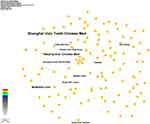 |
Figure 3 Map of active institutions on tuina treatment research for analgesia. |
Analysis of Journals and Co-Cited Journals
The characteristics of the journals which published tuina analgesia research was analyzed to quantify the number of publications, impact factor, and citations, and the top 10 journals with the most publications and citations were recorded (Table 3). 324 journals were included in the analysis, and 24 journals with publications greater than five were selected for visual analysis (Figure 4). As observed in the Figure 4, the journals with the highest number of publications were the Cochrane Database of Systematic Reviews, with 22 publications, followed by Evidence-Based Complementary and Alternative Medicine, the Journal of Manipulative and Physiological Therapeutics Evidence-Based Complementary and Alternative Medicine, Journal of Manipulative and Physiological Therapeutics, Medicine, and Complementary Therapies In Medicine, all with more than 10 articles. According to the Journal Citation Report (2022), the average impact factor (IF) of these 10 journals was 3.43.
 |
Table 3 Top 10 Relevant Journals and Co-Cited Journals on Tuina for Analgesia Research |
 |
Figure 4 Map of active journals producing publications about tuina treatment research for analgesia. |
Overall, 7050 co-cited journals were included in this study. The 109 co-cited journals with a citation frequency ≥ 50 were selected for visual analysis (Figure 5). In this visualization, the distance between two journal nodes approximates the relevance of the journals in terms of co-citation, and the closer the distance, the stronger the relevance of the two journals. As listed in Table 3, the most frequent occurrences were PAIN, with 306 instances, followed by the Cochrane Database of Systematic Reviews, Journal Of The American Medical Association (JAMA), British Medical Journal (BMJ), and the Lancet, each appearing more than 150 times.
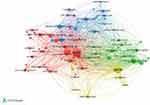 |
Figure 5 Map of co-cited journals producing publications about tuina treatment research for analgesia. |
The higher the citation frequency of the literature, the greater the importance and impact. Knowing the journals and co-cited journals allows you to keep track of the impact of current research.
Analysis of Authors and Co-Authors
A total of 3015 authors contributed to 621 articles, and 148 authors with postings greater than two were selected for visualization and analysis, for ease of analysis (Figure 6). The connections between authors can be observed in the plots. The top ten authors are listed in Table 4, and the author with the highest number of publications was WJJ Assendelft, with 4 publications. The “YEAR” in the table represents the year at the time of the first article published by the author.
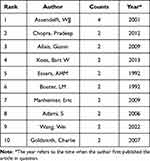 |
Table 4 Top 10 Authors Who Performed Research on Tuina for Analgesia |
 |
Figure 6 Map of authors who study tuina treatment for analgesia. |
Co-cited authors are two or more authors who are cited by other literature at the same time. We screened 48 authors with more than 20 citations from the 19,923 co-cited authors for visual analysis (Figure 7). As listed in Figure 7 and Table 5, among the co-cited authors, R Melzack had the highest citation frequency (54), while E Ernst and AD Furlan also had more than 35 citations. R Chou had the highest centrality (0.31), while R Melzack and AD Furla also had a high centrality (>0.2). Analyzing out the lead authors and co-authors is an important means of identifying potential collaborators, who are more specialized in this area of research.
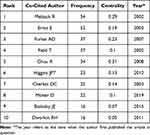 |
Table 5 Top 10 Co-Cited Authors Who Performed Research on Tuina for Analgesia |
 |
Figure 7 Map of co-cited authors who study tuina treatment for analgesia. |
Analysis of Co-Occurring Keywords
Co-occurring keywords are those in which two or more keywords appear in other literature at the same time. In this study, 100 keywords with more than 10 co-occurrences were selected from a total of 3021 keywords for better visualization (Figure 8). The top 10 co-occurring keywords are listed in Table 6. As shown in the Figure 8, “Management”, “Therapy” and “Pain” were the three most frequent keywords, with 109, 71, and 69 occurrences, respectively. The other 7 keywords had frequencies of more than 40 occurrences. “Acupuncture” had the highest centrality (0.19), followed by “Therapy” and “Double Blind”, both with a centrality of 0.15. From the keyword-density map (Figure 9), we found three high-density nuclei centered on “pain, massage”, “acupuncture, efficacy”, and “manual therapy”, reflecting the current research hot topics, which is consistent with the frequency and centrality of the keywords.
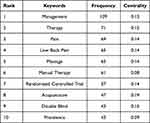 |
Table 6 Top 10 Co-Occurrence Keywords Related to Tuina for Analgesia Research |
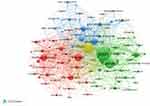 |
Figure 8 Map of co-occurrence keywords from publications about tuina treatment for analgesia. |
 |
Figure 9 Keywords density map of tuina treatment for analgesia. |
Analysis of Co-Cited References
A total of 621 items of literature and 26,032 references were included. The top 10 co-cited literature in order of co-citations are given in Table 7. The most cited literature was “Pain Mechanisms - A New Theory” with 29 citations, and the remaining 9 literature items had more than 14 but less than 20 citations. Three of the 10 pieces of literature were randomized controlled trials and 7 were systematic evaluations and Meta-analyses. The average impact factor of the 10 literature items was 42.49.
 |
Table 7 Top 10 Co-Cited References Related to Tuina for Analgesia |
Analysis of Burst Keywords
“Burst keywords” refer to keywords that have been frequently cited overtime, showing the frontier areas of research. Figure 10 shows the 10 emergent keywords sorted by “year of start”. As can be observed, research on “cervical spondylosis” appeared in 2000 and continued until 2006. Subsequently, “lower back pain” became a research hot topics from 2003–2008, and “systematic review” was most common (Strength=6.86) from 2018–2023. The latest research hot topics are postoperative pain, efficiency, and anxiety, which may be potential future research hot topics in the field.
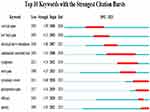 |
Figure 10 Top 10 keywords with the strongest citation bursts. |
Discussion
This study utilizes the WoSCC Core Collection to conduct a bibliometric analysis of the impact of research related to tuina analgesia over the last 30 years to gain a comprehensive understanding of the global research trends and hot topics for researchers in the field or those who are interested in the field. The contribution of this study is to reveal visually the countries/regions, institutions, co-authors of authors, journals and co-cited journals, as well as popular keywords and references that have had a significant impact on tuina analgesia research. Our study emphasizes the role of tuina analgesia in pain management, especially in strategies for treating LBP. Although medication is widely recognized as the most effective treatment for pain patients, our findings suggest that non-pharmacological treatments represented by tuina and acupuncture are also expected to be the future treatment for pain. Nevertheless, inter-country and inter-institutional cooperation and communication should be strengthened to promote the development of this field for the benefit of more pain patients.
Tuina is an effective and safe adjunctive intervention for the treatment of some pain disorders, especially for peripherally-induced neuropathic pain.22 Although some reviews have explored the application of pain relief of tuina, the content is limited and mostly disease-specific.23–26 Therefore, key issues such as publication trends, the current status of research, and research hot topics in the field of tuina analgesia need to be addressed. In this study, we have quantified the literature in the field of tuina analgesia over the past 30 years using bibliometric methods, thereby visualizing the above factors for the first time and providing a reference for further research in the field of tuina analgesia.
Our studies have shown that the annual number of publications and citations in the field of tuina analgesia has shown a fluctuating upward trend, with a significant increase after 2008. Based on this, it can be expected that research on pain relief of tuina will continue to increase. The top 5 countries accounted for 62.16% of the total number of articles published. In terms of centrality, the United States, the United Kingdom, and Canada were highest and were the countries who exhibited extensive international cooperations, which is consistent with the current concentration of research centers in the Americas and Europe in this field. Although China ranked second considering the number of publications, its centrality was low, which indicates that although China conducts a large number of studies on pain relief of tuina, it has fewer high-quality publications. Authors of the publications were mainly from the Americas and Europe, and among the top 10 authors of publications, only 1 was from China, with a publication date of 2022. This represents a large gap from China’s second ranking in terms of publication volume, indicating that relevant research in China has been conducted more recently with a weak research base and low influence of researchers. The cooperation network among authors showed obvious clusters and the connections between clusters were not strong, suggesting authors in this field should strengthen international cooperations. In terms of inter-institutional cooperation, there was a relatively loose polycentric distribution with sparse connectivity among institutions. This implies that there is currently less exchange and cooperation among institutions and a stable cooperation network has not yet been formed. From the ranking of issuing institutions, Chinese institutions occupy half of the top 10. Although they do not take advantage of this geographical advantage to actively cooperate and promote further development of research strength, this indicates that the research focus in this field has also gradually shifted to Asia, especially China, in recent years. Among the Chinese institutions, three were Traditional Chinese Medicine (TCM) universities, indicating that TCM universities are still the main institutions researching pain relief of tuina in China, which is reflective of tuina as an important component of TCM. In the analysis of published journals, the top 10 journals were all academic journals with an average IF of 3.43. This indicates that few publications in this field of research are published in high-impact journals, which may be related to the low-quality of clinical reports on tuina analgesia research,27,28 thus relevant clinical research needs to be deepened and strengthened. High-quality clinical studies facilitate the distribution of high-quality publications, and publications in high-quality journals facilitate the exchange of research results. In the analysis of co-cited journals, PAIN, Cochrane Database of Systematic Reviews, and JAMA are the core journals in this field, with an average impact factor of 59.08, confirming that publishing in high-quality journals is more helpful for the communication of research results. The keywords reflect the current research hot topics. In the analysis of keywords in this field, management, therapy, and pain appear most frequently and are therefore the focus of current research. Pain management is now integrated in treatment strategies for a variety of pain conditions, such as in the 2017 American College of Physicians (ACP) clinical practice guideline for chronic low back pain (LBP),29 the European Academy of Neurology (EAN) guidelines on central neurostimulation therapy in chronic pain conditions,30 and Chronic Pain Management in the Elderly.31 Currently, there are specialized organizations for acute pain services (APS) for patients to provide a reference for clinical pain management. However, this systematic model does not fully meet the diverse needs and applications for different regions, countries, and hospitals.32 LBP, as the only disease term in the top 10 keywords, is the current disease focus for tuina analgesia research. In the guidelines for LBP, for patients with acute or subacute low back pain, it is recommended to employ nonpharmacological treatment, including tuina, or pharmacological treatment, such as NSAIDs, or skeletal muscle relaxants when these are ineffective. For patients with chronic LBP, it is recommended to employ nonpharmacological treatment such as exercise, tuina and acupuncture initially. Acupuncture and tuina, representing nonpharmacological interventions, appear together in the treatment of multiple pain disorders and pain management.33–35 In addition, clinical trials implemented under a double-blind method are an important part of the research, and highly therapeutic clinical studies provide evidence to support the effectiveness of tuina analgesia.
The emergent keywords show the current frontiers of research. In this study, the three most recent emergent words were postoperative pain, efficiency, and anxiety. Postoperative pain management is receiving increasing attention,36 and nonpharmacological treatments such as acupuncture and tuina are often used as initial options after some postoperative pain becomes chronic.37 Emotional factors are a focus of the latest research in the field of analgesia, and some studies38 have shown anxiety as a risk factor for postoperative chronic pain that needs to be focused on by caregivers. In addition, systematic evaluation has maintained a high level of prevalence from the beginning of 2018 until now, while the prevalence for studies regarding efficacy has also gradually increased during the period, suggesting that research on the clinical efficacy and mechanisms of pain relief of tuina has received extensive attention in recent years.39–42 Overall, there are several potential mechanisms by which pain relief of tuina is achieved. The first potential mechanism is inhibition of peripheral inflammation, as studies43,44 have shown that tuina can modulate the levels of inflammatory factors to relieve pain, such as tumor necrosis factor-α (TNF-α) and interleukin (IL-6). Another mechanism may be the modulation of ion channels. Throughout the stages of pain projection, the most involved cell type is the sensory neuron, whose sensitivity can be modulated by various mediators. Accordingly, the transmission and processing of pain signals depends heavily on the activity of ion channels, which are either voltage-gated, ligand-gated, or mechanosensitive. Studies have shown that the use of clockwise pressing and kneading in CCD (chronic compression of dorsal, CCD) rats combined with reduced expression of Piezo1 indicates that tuina provides analgesia through mechanosensitive ion channels.45 Another potential mechanism is through the inhibition of spinal glial cell activation. The molecular mechanism responsible for neuronal and glial plasticity is widely accepted as a mechanism which supports the transition from acute/physiological pain to chronic/pathological pain, occurring after nerve injury, and glial cell activation.46 Researchers47 have observed that glial cells in nerve-injured rats underwent significant changes before and after tuina manipulation, confirming that tuina can relieve pain by inhibiting glial cell activation. The final potential mechanism is through modulation of brain function. The brain is the site of the generation of pain signals, which are the transmitted from nociceptive fibers to the spinal cord. From there, they exchange neurons in the posterior horn and traverse across to the contralateral spinothalamic, dorsal column, and spinal cervical tracts. The signals rise to certain nuclei in the thalamus, primarily the medial nucleus cluster, parabasal nucleus, and central nucleus, which in turn project to somatosensory areas of the cerebral cortex. Furthermore, the nociceptive signal diffuses up the spinal cord, along the spinal reticular fibers, spinal midbrain fibers, and the old spinal vertical tract to reach the brainstem reticular formation, the medial thalamus, and the limbic system; a pain conduction pathway collectively referred to as the paracentral system. The signals generated by tuina manipulation are also transmitted along this same pain conduction pathway, and these signals reach the same part of the central nervous system. Therefore, because of this shared pathway, the impulses generated by pain may be inhibited by the pain generated by tuina, leading to analgesia.48 In summary, the study of analgesic mechanisms of tuina should be closely integrated with the latest results of research in neuroanatomy, pathophysiology, and molecular biology. Understanding the molecular and cellular mechanisms of pain, through a combination of animal and human experiments, is essential to improve knowledge of pain physiopathology, identify new therapeutic targets, and ultimately improve pain management. If its mechanism of action can be elucidated, it will have a favorable impact on the clinical treatment and theoretical research of tuina analgesia and guide its further development.
Limitations
First, although the Web of Science database is a reliable source of data with high-quality articles on pain relief of tuina, the data were extracted from this source only, and published articles may therefore have been missing. Second, our study included only English publications, and other languages were not analyzed. Third, because the qualitative analysis is relatively subjective to the researcher, different observer perspectives may lead to different conclusions. The results of this study reflect only the dynamics of academic research in the field, which is the primary purpose of this bibliometric study.
Conclusion
In this bibliometric analysis, the results characterize the current status of publications in the field of tuina analgesia, as well as the research hot topics, frontiers, the potential collaborators, institutions, hot topics, and future research trends, which will help guide new research directions of tuina analgesia. Our analysis shows a general trend of growth in the number of articles issued, demonstrating that this research field still has a promising future. Research on the efficacy and mechanism of massage analgesia is a major direction in this field. Postoperative pain, efficiency, and anxiety, which may be potential future research hot topics in the field. We can look forward to a higher level of international exchange and collaboration in the future, as well as well-designed studies to guide research on tuina analgesia.
Abbreviations
WoSSC, Web of Science Core Collection; TCM, traditional Chinese medicine; IF, impact factor; ACP, American College of Physicians; LBP, low back pain; EAN, European Academy of Neurology; APS, acute pain services; TNF-α, tumor necrosis factor-α; IL, interleukin.
Acknowledgments
This work was supported by grants from the National Natural Science Foundation of China (No.81874513), the Central Plains Thousand Talents Program-Central Plains Famous Doctors (No.ZYQR201912120), Henan Provincial Science and Technology R&D Program Joint Fund (superior discipline cultivation category) (No.222301420061), Henan Province Science and Technology Tackling Program Project (No. 222102310214), 2023 Henan Province's “Double First Class” Creation Discipline Traditional Chinese Medicine Scientific Research Special Project (No. HSRP-DFCTCM-2023-7-09), and 2023 Henan Province's “Double First Class” Creation Discipline Traditional Chinese Medicine Scientific Research Special Project (No. HSRP-DFCTCM-2023-8-11).
Author Contributions
All authors made a significant contribution to the work reported, whether that is in the conception, study design, execution, acquisition of data, analysis and interpretation, or in all these areas; took part in drafting, revising or critically reviewing the article; gave final approval of the version to be published; have agreed on the journal to which the article has been submitted; and agree to be accountable for all aspects of the work.
Disclosure
The authors declare no conflicts of interest in this work.
References
1. Ernst E. The safety of massage therapy. Rheumatology. 2003;42(9):1101–1106. doi:10.1093/rheumatology/keg306
2. Miake-Lye IM, Mak S, Lee J, et al. Massage for pain: an evidence map. J Alternative Complemen Med. 2019;25(5):475–502. doi:10.1089/acm.2018.0282
3. Sufka KJ, Lynch MP. Sensations and pain processes. Philos Psychol. 2000;13(3):299–311. doi:10.1080/09515080050128132
4. Reynolds CA, Minic Z. Chronic pain-associated cardiovascular disease: the role of sympathetic nerve activity. Int J Mol Sci. 2023;24(6). 5378. doi:10.3390/ijms24065378
5. Li YX, Pang J, Liang YY, Lu DM, Tang HL. Research progress on the mechanism of action of Tui Na in relieving neuropathic pain. Guangxi Med J. 2022;44(13):1527–1531.
6. Mo Z, Li D, Zhang R, Chang M, Yang B, Tang S. Comparisons of the Effectiveness and Safety of Tuina, Acupuncture, Traction, and Chinese Herbs for Lumbar Disc Herniation: a Systematic Review and Network Meta-Analysis. Evid Based Complemen Alternative Med. 2019;2019:1–10. doi:10.1155/2019/6821310
7. Tsao JCI. Effectiveness of massage therapy for chronic, non-malignant pain: a review. Evid Based Complemen Alternative Med. 2007;4(2):165–179. doi:10.1093/ecam/nel109
8. Dorea FC, Revie CW. Data-driven surveillance: effective collection, integration, and interpretation of data to support decision making. Front Veterinary Sci. 2021;8:633977. doi:10.3389/fvets.2021.633977
9. van Eck NJ, Waltman L. Citation-based clustering of publications using CitNetExplorer and VOSviewer. Scientometrics. 2017;111(2):1053–1070. doi:10.1007/s11192-017-2300-7
10. Chen CM. Searching for intellectual turning points: progressive knowledge domain visualization. Proc Natl Acad Sci U S A. 2004;101:5303–5310. doi:10.1073/pnas.0307513100
11. Zhang Y, Li C, Ji X, Yun C, Wang M, Luo X. The knowledge domain and emerging trends in phytoremediation: a scientometric analysis with CiteSpace. Environ Sci Pollution Res. 2020;27(13):15515–15536. doi:10.1007/s11356-020-07646-2
12. Liu Z, Wang H, Yu T, Zhang Y, Jiao Y, Wang X. Tuina for peripherally-induced neuropathic pain: a review of analgesic mechanism. Front Neurosci. 2022:16.
13. Arslan DE, Kutluturkan S, Korkmaz M. The Effect of Aromatherapy Massage on Knee Pain and Functional Status in Participants with Osteoarthritis. Pain Manage Nursing. 2019;20(1):62–69. doi:10.1016/j.pmn.2017.12.001
14. Erdogan SU, Yanikkerem E, Goker A. Effects of low back massage on perceived birth pain and satisfaction. Complement Ther Clin Pract. 2017;28:169–175. doi:10.1016/j.ctcp.2017.05.016
15. Ren N, Yang G, Ren X, Li L. Effects of foot massage on relieving pain, anxiety and improving quality of life of patients undergone a cervical spine surgery. Health Quality Life Outcomes. 2021;19(1):45. doi:10.1186/s12955-021-01667-2
16. Yang J, Chen S, Hsieh C, Lin J. Effects and predictors of shoulder muscle massage for patients with posterior shoulder tightness. BMC Musculoskelet Disord. 2012:13. doi:10.1186/1471-2474-13-13
17. Furlan AD, Giraldo M, Baskwill A, Irvin E, Imamura M. Massage for low-back pain. Cochrane Database Sys Rev. 2015;2015(9):45. doi:10.1002/14651858.CD001929.pub3
18. Lee S, Kim J, Yeo S, Kim S, Lim S. Meta-analysis of massage therapy on cancer pain. Integr Cancer Ther. 2015;14(4):297–304. doi:10.1177/1534735415572885
19. Qaseem A, Wilt TJ, McLean RM, Forciea MA, Amer CP. Noninvasive treatments for acute, subacute, and chronic low back pain: a clinical practice guideline from the American college of physicians. Ann Intern Med. 2017;166(7):142–514.
20. Cruccu G, Garcia-Larrea L, Hansson P, et al. EAN guidelines on central neurostimulation therapy in chronic pain conditions. Eur J Neurol. 2016;23(10):1489–1499. doi:10.1111/ene.13103
21. Schwan J, Sclafani J, Tawfik VL. Chronic pain management in the elderly. Anesthesiol Clin. 2019;37(3):547–560. doi:10.1016/j.anclin.2019.04.012
22. Qin L, Xie XM. Research progress of pain management. Chine Nursing Manage. 2016;16(1):121–124.
23. Ding F, Liu Z, Li R, Wang C, Lu Y. Acupuncture plus massage for cervicogenic headache A protocol for systematic review and meta-analysis. Medicine. 2022;101(4):e28736. doi:10.1097/MD.0000000000028736
24. Klassen E, Wiebelitz K, Beer A. Classical massage and acupuncture in chronic back pain - non-inferiority randomised Trial. Z Orthop Unfall. 2019;157(3):263–269. doi:10.1055/a-0715-2332
25. Wang Z, Wang Y, Wang C, et al. Systematic Review and Network Meta-analysis of Acupuncture Combined with Massage in Treating Knee Osteoarthritis. Biomed Res Int. 2022;2022:56.
26. Khouly I, Braun RS, Ordway M, et al. Post-operative pain management in dental implant surgery: a systematic review and meta-analysis of randomized clinical trials. Clin Oral Investig. 2021;25(5):2511–2536. doi:10.1007/s00784-021-03859-y
27. Berkowitz RA, McDonald TB. Post-operative pain management. Indian J Pediatr. 1997;64(3):351–367. doi:10.1007/BF02845204
28. Lovich-Sapola J, Smith CE, Brandt CP. Postoperative Pain Control. Surg Clin North Am. 2015;95(2):301. doi:10.1016/j.suc.2014.10.002
29. Cheng YH, Huang GC. Efficacy of massage therapy on pain and dysfunction in patients with neck pain: a systematic review and meta-analysis. Evid Based Complemen Alternative Med. 2014;2014:204360. doi:10.1155/2014/204360
30. Salarvand S, Heidari ME, Farahi K, Teymuri E, Almasian M, Bitaraf S. Effectiveness of massage therapy on fatigue and pain in patients with multiple sclerosis: a systematic review and meta-analysis. Multiple Sclerosis J Exp Translational Clin. 2021;7(2):205521732110227. doi:10.1177/20552173211022779
31. Yeun Y Effectiveness of massage therapy for shoulder pain: a systematic review and meta-analysis. J Phys Therapy Sci. 2017;29(5):936–940. doi:10.1589/jpts.29.936
32. Zhou K, Dong S, Bai X, et al. Effects and safety of massage therapy for patients with metatarsal pain A protocol for systematic review and meta-analysis. Medicine, 2020,99:49.
33. Ellis A, Bennett DLH. Neuroinflammation and the generation of neuropathic pain. Br J Anaesth. 2013;111(1):26–37. doi:10.1093/bja/aet128
34. Yang JK, Wang JW, Zhou KW, Shu JF. Study on Curative Effect of Duhuo Jisheng Decoction Combined with Tuina in Patients with Lumbar Disc Herniation and Changes of TXB2, TNF-α and IL-1β. Chine Arch Traditional Chine Med, 2020,38(2):44–46.
35. Song P, Lin Z, Zhu Q, et al. Possible mechanism underlying analgesic effect of Tuina in rats may involve piezo mechanosensitive channels within dorsal root ganglia axon. J Traditional Chine Med. 2018;38(6):834–841. doi:10.1016/S0254-6272(18)30982-8
36. Nair S, Sobotka KS, Joshi P, et al. Lipopolysaccharide-induced alteration of mitochondrial morphology induces a metabolic shift in microglia modulating the inflammatory response in vitro and in vivo. GLIA. 2019;67(6):1047–1061. doi:10.1002/glia.23587
37. Mo Z, Li D, Zhang R, Chang M, Yang B, Tang S. Comparisons of the Effectiveness and Safety of Tuina, Acupuncture, Traction, and Chinese Herbs for Lumbar Disc Herniation: a Systematic Review and Network Meta-Analysis. Evid Based Complemen Alternative Med, 2019 2019. 1–10
38. Li JH, Gong L, Fang M. Research progress on pain mechanism of knee osteoarthritis and tui na treatment. Chine J Traditional Med Traumatology Orthopedics, 2010,18(03):68–69.
39. Melzack R, Wall PD. Pain mechanisms: a new theory. Science. 1965;150(3699):971–979. doi:10.1126/science.150.3699.971
40. Bialosky JE, Bishop MD, Price DD, et al. The mechanisms of manual therapy in the treatment of musculoskeletal pain: a comprehensive model. Man Ther. 2009;14(5):531–538. doi:10.1016/j.math.2008.09.001
41. Cherkin DC, Eisenberg D, Sherman KJ, et al. Randomized trial comparing traditional Chinese medical acupuncture, therapeutic massage, and self-care education for chronic low back pain. Arch Intern Med. 2001;161(8):1081–1088. doi:10.1001/archinte.161.8.1081
42. Chou R, Qaseem A, Snow V, et al. Diagnosis and treatment of low back pain: a joint clinical practice guideline from the American College of Physicians and the American Pain Society. Ann Intern Med. 2007;147(7):478–491. doi:10.7326/0003-4819-147-7-200710020-00006
43. Eisenberg DM, Davis RB, Ettner SL, et al. Trends in alternative medicine use in the United States, 1990-1997: results of a follow-up national survey. JAMA. 1998;280(18):1569–1575. doi:10.1001/jama.280.18.1569
44. Field T, Hernandez-Reif M, Taylor S, et al. Labor pain is reduced by massage therapy. J Psychosom Obstet Gynaecol. 1997;18(4):286–291. doi:10.3109/01674829709080701
45. Jadad SR, Moore RA, Carroll D, et al. Assessing the quality of reports of randomized clinical trials: is blinding necessary? Control Clin Trials. 1996;17(1):1–12. doi:10.1016/0197-2456(95)00134-4
46. Moyer CA, Rounds J, Hannum JW A meta-analysis of massage therapy research. Psychol Bull. 2004;130(1):3–18. doi:10.1037/0033-2909.130.1.3
47. Soden K, Vincent K, Craske S, et al. A randomized controlled trial of aromatherapy massage in a hospice setting. Palliat Med. 2004;18(2):87–92. doi:10.1191/0269216304pm874oa
48. Higgins JP, Thompson SG, Deeks JJ, et al. Measuring inconsistency in meta-analyses. BMJ. 2003;327(7414):557–560. doi:10.1136/bmj.327.7414.557
 © 2023 The Author(s). This work is published and licensed by Dove Medical Press Limited. The full terms of this license are available at https://www.dovepress.com/terms.php and incorporate the Creative Commons Attribution - Non Commercial (unported, v3.0) License.
By accessing the work you hereby accept the Terms. Non-commercial uses of the work are permitted without any further permission from Dove Medical Press Limited, provided the work is properly attributed. For permission for commercial use of this work, please see paragraphs 4.2 and 5 of our Terms.
© 2023 The Author(s). This work is published and licensed by Dove Medical Press Limited. The full terms of this license are available at https://www.dovepress.com/terms.php and incorporate the Creative Commons Attribution - Non Commercial (unported, v3.0) License.
By accessing the work you hereby accept the Terms. Non-commercial uses of the work are permitted without any further permission from Dove Medical Press Limited, provided the work is properly attributed. For permission for commercial use of this work, please see paragraphs 4.2 and 5 of our Terms.
